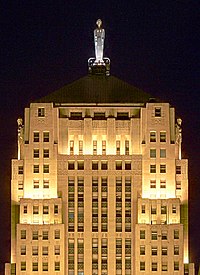The Paramount Theatre and Arts Center in Aurora Illinois first opened in 1931. It is located in Aurora downtown at 23 E. Galena Boulevard in the Stolp Island Historic District. The building was designed by architects Rapp and Rapp in the Art Deco style with some Venetian details and it was commissioned by J.J. Rubens for one million dollars. The Rapps were famous for designing theaters. The building underwent a restoration in 1978 and was added to the National Register of Historic Places in 1986. The building can hold approximately 1,885 people and was the first air conditioned building outside of Chicago. It’s owned and operated by the Aurora Civic Center Authority.
Paramount Pictures started establishing theaters to show their own films in the 1920s. Talkies had just started and Paramount predicted it would lead to high demand in the industry. The old theaters were primarily designed to show live theater, not films. The Paramount Theatre in Aurora opened in September 1931 with appearances by famous Paramount film stars: The Marx Brothers, Jack Benny and Burns and Allen.
Today, the Paramount Theatre and Arts Center features Broadway style live peformances, musical concerts and live comedy. Some upcoming performances include the 2018-19 Broadway Series, Once (the musical), Diana Krall, Judy Garland: Come Rain or Come Shine, Stayin’ Alive Bee Gees tribute band, Happy Together Tour 2018 and Classic Movie Mondays. It has more than 36,000 subscribers that enjoy the Paramount’s Broadway quality productions at affordable prices, making it the second largest subscription theatre in the nation.








- Note – Indoor photos are from Google and Wikipedia














































